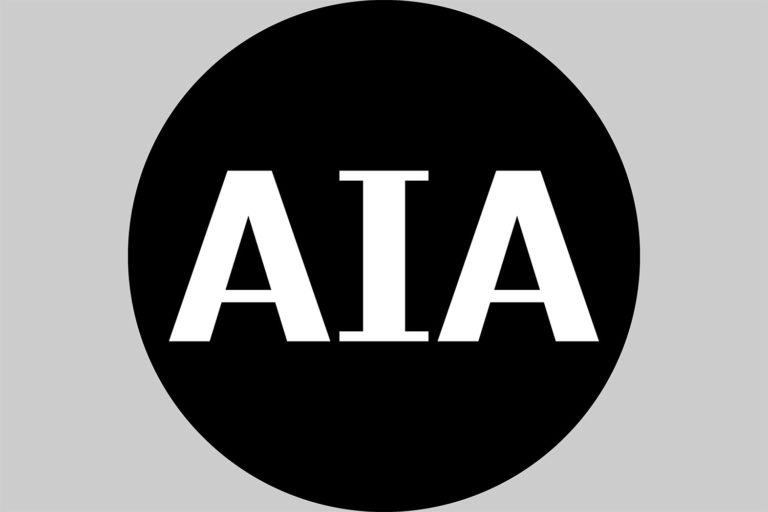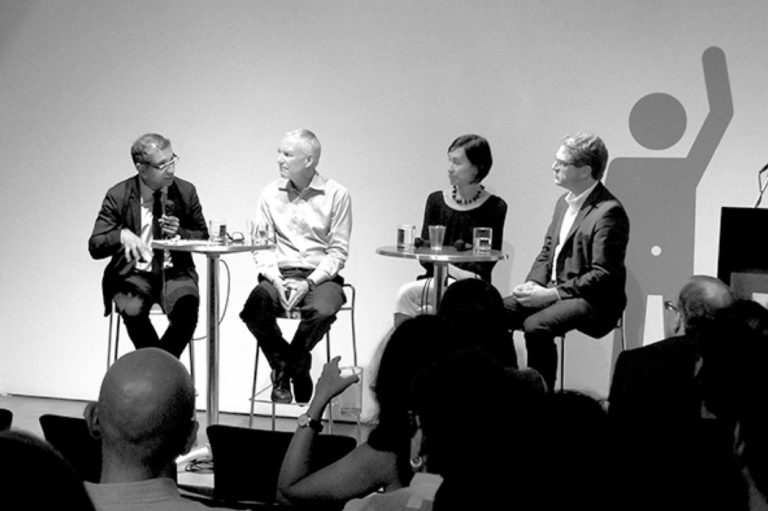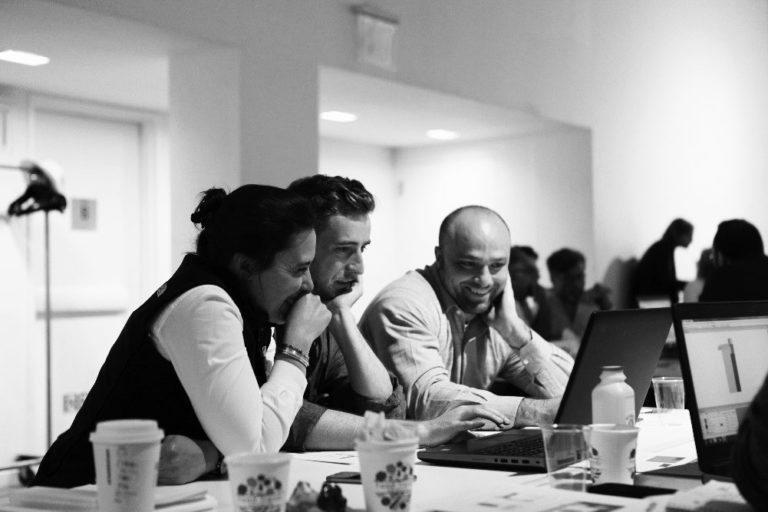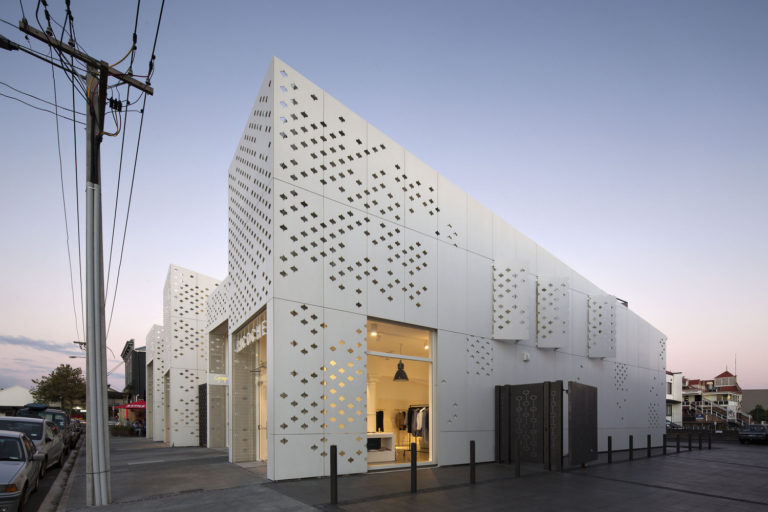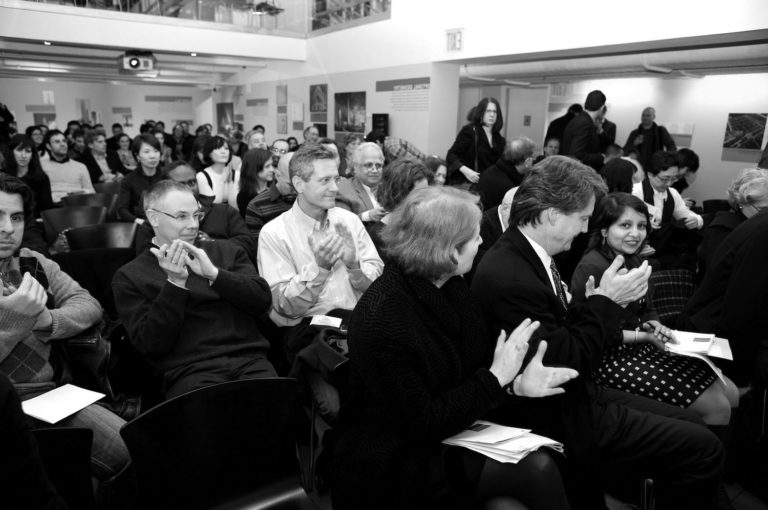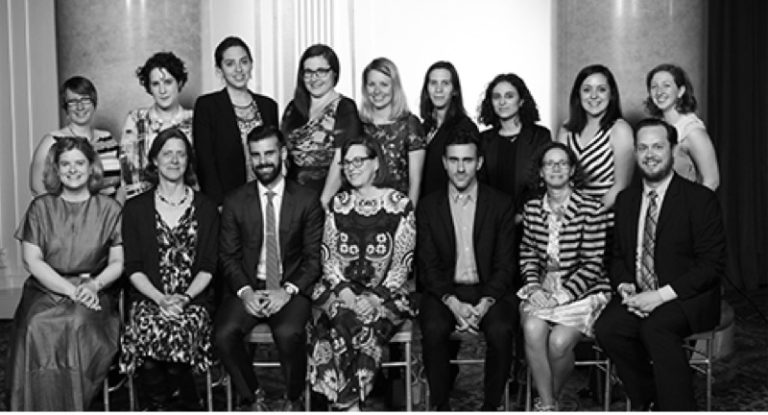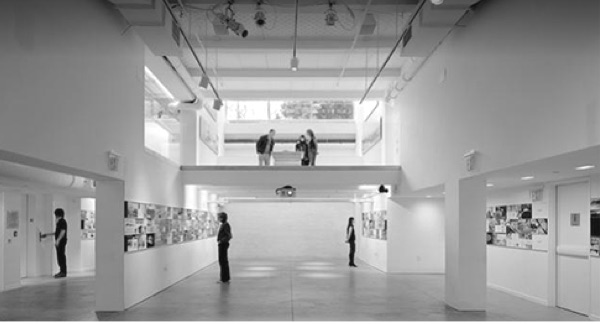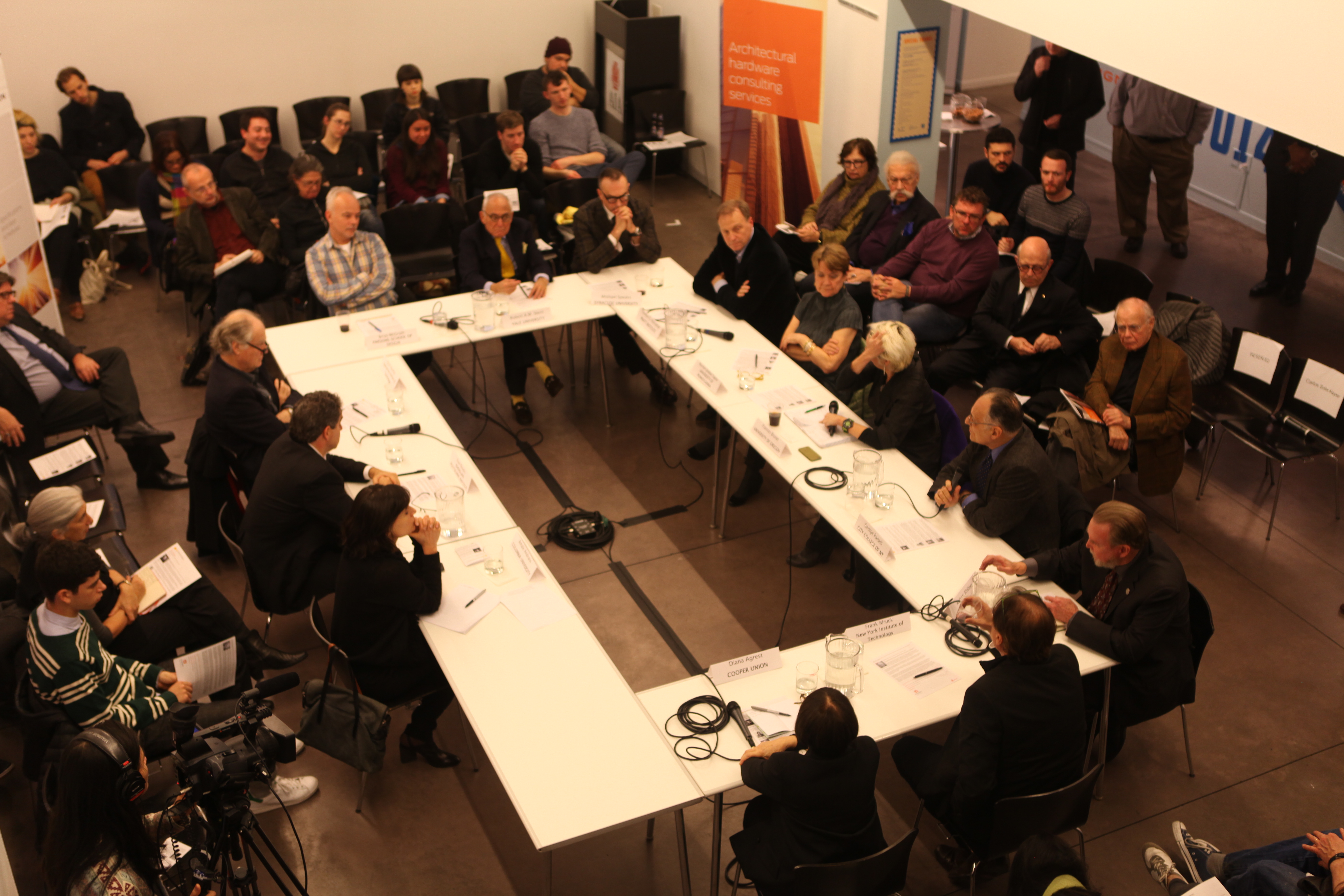by: Alexandra Tell
Leadership was the theme of the night, as 13 deans from architecture schools around the New York area gathered for the 10th annual Deans’ Roundtable. Lance Jay Brown, FAIA, introduced the panel. Invoking his 2014 presidential theme of “Civic spirit: Civic Vision” as a guidepost for thinking about leadership within architectural education, Brown urged the panelists to think about the role that their institutions play in fostering communities and cities, both locally and internationally. He set the stage for a conversation amongst the deans in which ideas about pedagogy, professionalism, institutional structures, and the role of architectural practice within society unfolded.
Moderator Frances Bronet, senior vice president and provost of the University of Oregon and former dean of the School of Architecture, opened the panel by taking an informal poll of the audience, asking students, educators, and practicing architects to identify themselves by a show of hands. Bronet then acknowledged a particular subset of the audience – future architecture students – setting the stage for a recurring emphasis on the future of architectural education.
The deans hovered around these vital questions through the lens of leadership: What is the state of architectural education today, and how can architecture schools prepare for the future, and prepare students to confront the future? The panelists seemed to consider leadership in two distinct, but interrelated ways. The deans reflected on the current state of leadership – their own roles within academic institutions and architectural discourse – and the future of leadership – how schools cast the mold for the next generation of leaders. As the panelists batted around definitions of leadership, self-reflected on their own methods of leading, and articulated their visions for future leaders, it became clear that these 13 New York area institutions reflect a wide range of architectural pedagogies, from technical, career-oriented architectural education to a more theoretical, humanistic approach.
The deans, drawn from art and design schools like Cooper Union and Parsons to technical schools like NYIT and NJIT, and large universities including Yale, Columbia, and University of Pennsylvania, each spoke to their unique academic setting and how it informed their approach to architectural education. Marilyn Jordan Taylor, FAIA, dean of PennDesign at the University of Pennsylvania, spoke about building connections with other disciplines within her university. Her architecture program encourages collaboration – with nursing students in designing better hospitals, or with business students to understand the economics behind design. While a large university like Penn is an ideal setting for interdisciplinary collaboration, Fred Shibley, FAIA, dean of School of Architecture and Planning at SUNY Buffalo, spoke about his program’s engagement with the urban milieu. “In our school, we are rooted in context,” said Shibley, noting that he encourages his students to engage with the city of Buffalo and its particular set of architecture and urban planning issues. Brian McGrath, dean of the School of Constructed Environments at Parsons, celebrated these distinct approaches, pointing to a historical monotony in architecture pedagogy. “We should make a pact to do differently, and each of us should do differently,” McGrath encouraged.
The most heated debate arose over the concept of “professionalism.” Robert A.M. Stern, FAIA, dean of Yale School of Architecture, boldly pronounced that most architecture schools today are not rearing competent architects. Amale Andraos, Assoc. AIA, dean of GSAAP at Columbia, countered Stern’s assertion, stating, “We are not here to serve the profession.” Andraos, echoed by Diana Agrest, FAIA, dean of the School of Architecture at Cooper Union, and others, outlined a broader vision of what architectural education could provide. “Architecture is the last humanistic discipline,” Agrest said, explaining that architectural practice must engage with its social, political, aesthetic, and environmental context. While Stern insisted that “the profession is not an evil force,” and that architecture schools should aim to produce architects, Thomas Hanrahan, AIA, dean of School of Architecture at Pratt Institute, saw value in architecture school as a pursuit of knowledge, and found the tension between professionalism and the pursuit of knowledge to be healthy and productive.
While the deans all reflected on the current state of their institutions, the main outcome of the evening was a focus on the future. Faced with the world as it is today, how can, and how should, architecture schools provide students with an education that will enable them to confront today’s problems, and the problems to come? Most pertinent among these issues seemed to be the real and increasingly dangerous threats of climate change. As George Ranalli, AIA, dean of the Bernard and Anne Spitzer School of Architecture at City College of New York, remarked (in a sentiment reiterated by others): “The built environment is responsible for the state of the environment.” Both Ranalli and Urs P. Gauchat, Hon. AIA, dean of NJIT School of Architecture, emphasized that architectural discourse must not shy away from this responsibility towards the environment, and that both current and future leaders in the architectural field must be prepared to challenge the status quo of the profession. “Architects’ role in history is highly questionable, and must to be reevaulated,” Ranalli said.
Agrest agreed, emphasizing how important it is for architects to realize the socio-historical moment in which they are working. It is within the dean’s capacity to guide students towards this larger perspective on the contextual fabric from which architecture should flow – deans are there to set ideological agendas and provide a “trickle down consciousness,” to borrow Agrest’s phrasing. But, while deans do serve as intellectual community leaders and should set academic agendas accordingly, as Gauchat pointed out, such guidance should be done carefully so as to open up possibilities and provide an education that won’t be constraining. “We should provide students with a good basic education, but the important thing is to not have in mind an outcome for individual students that restricts them in any way,” Gauchat asserted.
Walking away from the deans’ roundtable, the sense was that architecture schools, whether they be in the business of producing practicing architects or offering students a humanistic pursuit, have a unique opportunity to stand as a vanguard for today’s most pressing issues. Evan Douglis, dean of Architecture at Rensselaer Polytechnic Institute, succinctly distilled the mission of leaders in the architectural academy. “You are providing space for freedom of thought, for the next generation of students to take risks, to do things that may not be customary or popular within the practice. Because those things are essential in order to anticipate the challenges of the 21st century.”
Alex Tell is a Public Information Assistant at the Center for Architecture.
Event: Arch Schools 2014 Exhibition Reception and Deans’ Roundtable
Location: Center for Architecture, 11.15.14
Speakers: Diana Agrest, FAIA, Professor, The Irwin S. Chanin School of Architecture, The Cooper Union for the Advancement of Science and Art; Amale Andraos, Assoc. AIA, Graduate School of Architecture, Planning and Preservation, Dean of Architecture, Columbia University;; Frank Mruk AIA, RIBA, Associate Dean, New York Institute of Technology; Evan Douglis, Dean, Architecture Rensselaer, Rensselaer Polytechnic Institute; Urs P. Gauchat, Hon. AIA, Dean, School of Architecture, New Jersey Institute of Technology; Thomas G Hanrahan, AIA, Dean, School of Architecture, Pratt Institute; Marilyn Jordon Taylor, FAIA, Dean, PennDesign, University of Pennsylvania; Brian McGrath, Dean, School of Constructed Environments, Parsons the New School for Design; George Ranalli, AIA, Dean of Architecture, Bernard and Anne Spitzer School of Architecture, The City College of New York; Robert Shibley, FAIA, Dean, School of Architecture and Planning, University at Buffalo (SUNY); Michael Speaks, Dean of Architecture, School of Architecture, Syracuse University; Robert A.M. Stern, FAIA, Dean, School of Architecture, Yale University; Frances Bronet, Senior Vice President and Provost, University of Oregon; Lance Jay Brown, FAIA, 2014 AIANY President
Organizers: Center for Architecture
Lead Sponsor: Allegion
